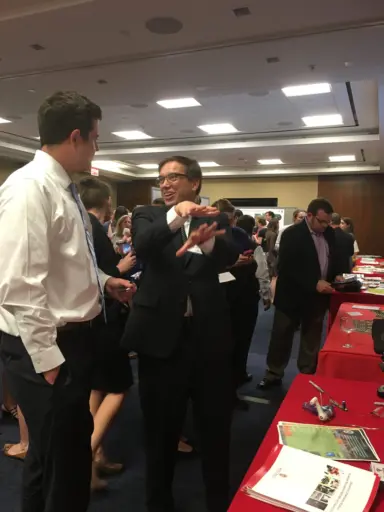While advances in basic science—the discoveries that lead to a better fundamental understanding of the world—are inherently exciting for scientists, the value of research that doesn’t have a direct commercial application can be less obvious to those outside a specialized scientific discipline.
Yet, communicating—to non-research audiences—the value of this basic federally funded research at the University of Wisconsin-Madison is critically important.
And with that aim in mind, Materials Science and Engineering Professor Paul Evans presented the relevance of the University’s materials research to members of Congress and their staff at the Coalition for National Science Funding’s (CNSF) 23rd annual exhibition and reception. Held at the Rayburn House Office Building in Washington, D.C., on May 16, 2017, the event gave scientists from more than 30 universities and professional associations the opportunity to engage with congressional staffers and showcase research and education projects supported by the National Science Foundation.
 At the CNSF’s 23rd annual exhibition and reception, Paul Evans shared with congressional aides some of MRSEC’s significant research accomplishments. Submitted photo.
At the CNSF’s 23rd annual exhibition and reception, Paul Evans shared with congressional aides some of MRSEC’s significant research accomplishments. Submitted photo.
With an exhibit at the event, Evans highlighted research, education and outreach activities from the NSF-sponsored Materials Research Science and Engineering Center (MRSEC) at UW-Madison. Directed by Nicholas Abbott, the John T. and Magdalen L. Sobota Professor and Hilldale Professor in chemical and biological engineering at UW-Madison, MRSEC is a large, highly interdisciplinary research center focused on the fundamental study of the structure and properties of interfaces at the nanoscale level of atoms and molecules.
Evans shared with congressional aides some of MRSEC’s significant research accomplishments. These include the discovery in one of the center’s interdisciplinary research groups of a new way to control molecular ordering within glass materials, an advance that could yield improvements in organic electronic devices or pharmaceuticals with better-understood properties. A seed project explored the formation of oxide materials by exploiting new crystallization methods and new nanoscale geometries for controlling crystal growth in ways that can lead to new electronic, optical, and thermal devices. Innovative education and outreach efforts building on these discoveries include new interactive digital games teaching key concepts about the dynamics of atoms.
“These are a few of the research advances from MRSEC that have made an impact in the field, led to intellectual property and to the development of highly trained students and postdocs,” Evans says. “Because MRSEC brings people from different disciplines together to work on complex problems, it helps expand the types of problems we can tackle at the university.”
Evans notes that in a highly competitive environment to win federal research funding, UW-Madison has been very successful, and that NSF funding has a far-reaching impact at the university and beyond. For example, the knowledge generated by MRSEC research goes on to benefit industry through the Wisconsin Advanced Materials Industrial Consortium at UW-Madison. Additionally, MRSEC supports the acquisition of shared research facilities and world-class scientific equipment at UW-Madison, and these shared facilities—including the Materials Science Center, Soft Materials Lab, and Wisconsin Center for Applied Microelectronics—allow many more people, both on campus and off, to access specialized instruments for research, education and outreach.
“NSF support really goes a long way at UW-Madison and has a significant and broad impact,” Evans says. “And that impact is underpinned by the basic science happening at MRSEC. The basic scientific research provides the foundation for highly valuable education and outreach activities.”